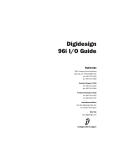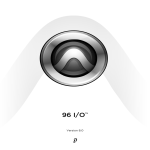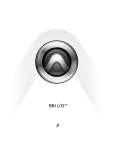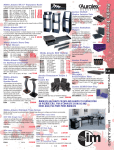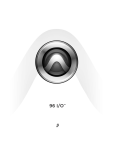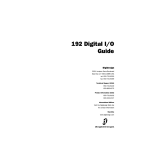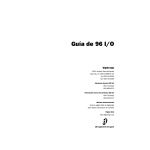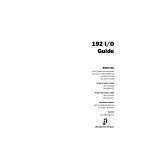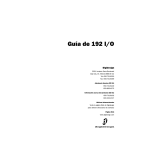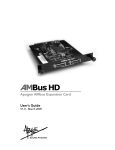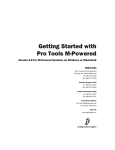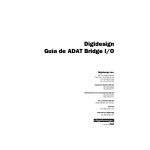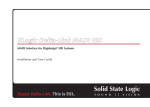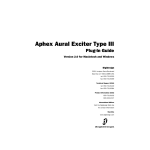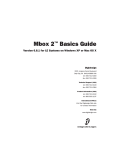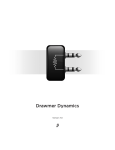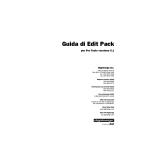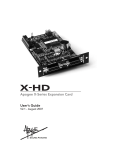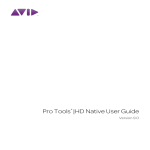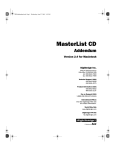Download DigiDesign ADAT Bridge I/O Specifications
Transcript
96 I/O Guide Digidesign 2001 Junipero Serra Boulevard Daly City, CA 94014-3886 USA tel: 650·731·6300 fax: 650·731·6399 Technical Support (USA) 650·731·6100 650·856·4275 Product Information (USA) 650·731·6102 800·333·2137 International Offices Visit the Digidesign Web site for contact information Web Site www.digidesign.com Copyright This guide is copyrighted ©2002 by Digidesign, a division of Avid Technology, Inc. (hereafter “Digidesign”), with all rights reserved. Under copyright laws, this guide may not be duplicated in whole or in part without the written consent of Digidesign. DIGIDESIGN, AVID and PRO TOOLS are trademarks or registered trademarks of Digidesign and/or Avid Technology, Inc. All other trademarks are the property of their respective owners. All features and specifications subject to change without notice. PN 910609282-00 REV B 09/03 Communications & Safety Regulation Information Compliance Statement The model 96 I/O complies with the following standards regulating interference and EMC: • FCC Part 15 Class A • EN55103 – 1, environment E4 • EN55103 – 2, environment E4 • AS/NZS 3548 Class A Radio and Television Interference This equipment has been tested and found to comply with the limits for a Class A digital device, pursuant to Part 15 of the FCC Rules. Communications Statement This equipment has been tested to comply with the limits for a Class A digital device. Changes or modifications to this product not authorized by Digidesign, Inc., could void the Certification and negate your authority to operate the product. This product was tested for CISPR compliance under conditions that included the use of peripheral devices and shielded cables and connectors between system components. Digidesign recommends the use of shielded cables and connectors between system components to reduce the possibility of causing interference to radios, television sets, and other electronic devices. Safety Statement This equipment has been tested to comply with USA and Canadian safety certification in accordance with the specifications of UL Standards; UL1419 and Canadian CSA standard; CSA C22.2 No.1-M90. Digidesign Inc., has been authorized to apply the appropriate UL & CUL mark on its compliant equipment. Important Safety Instructions When using electric or electronic equipment, basic precautions should always be followed, including the following: • Read all instructions before using this equipment. • To avoid the risk of shock, keep this equipment away from rain water, and other moisture. Do not use this equipment if it is wet. • The equipment should only be connected to the correct rating power supply as indicated on the product. • Do not attempt to service the equipment. There are no user-serviceable parts inside. Please refer all servicing to authorized Digidesign personnel. • Any attempt to service the equipment will expose you to a risk of electric shock, and will void the manufacturer’s warranty. • The product should be connected only to the correct power supply as indicated on the product. Warning! • HD audio interfaces need room at their sides to maintain proper air flow and cooling. • Do not install these units into a rack or other enclosure that doesn't leave room on either side for the unit fans. • Do not block the sides of the units (where fans are), or disconnect the fan. • If the units are racked up in a case, remove all lids, doors, or covers before operating the units. • Failure to do so can result in the units overheating very quickly, which can permanently damage them. contents Chapter 1. Introduction to the 96 I/O . . . . . . . . . . . . . . . . . . . . . . . . . . . . . . . . . . . . . . . . . 1 What’s Included . . . . . . . . . . . . . . . . . . . . . . . . . . . . . . . . . . . . . . . . . . . . . . . . . . . . . . . . . 1 System Requirements . . . . . . . . . . . . . . . . . . . . . . . . . . . . . . . . . . . . . . . . . . . . . . . . . . . . . 1 About This Guide . . . . . . . . . . . . . . . . . . . . . . . . . . . . . . . . . . . . . . . . . . . . . . . . . . . . . . . . . 2 About www.digidesign.com . . . . . . . . . . . . . . . . . . . . . . . . . . . . . . . . . . . . . . . . . . . . . . . . . 2 Chapter 2. 96 I/O Hardware Overview . . . . . . . . . . . . . . . . . . . . . . . . . . . . . . . . . . . . . . . . . 3 96 I/O Front Panel . . . . . . . . . . . . . . . . . . . . . . . . . . . . . . . . . . . . . . . . . . . . . . . . . . . . . . . 3 96 I/O Back Panel . . . . . . . . . . . . . . . . . . . . . . . . . . . . . . . . . . . . . . . . . . . . . . . . . . . . . . . 5 Chapter 3. Installation Overview . . . . . . . . . . . . . . . . . . . . . . . . . . . . . . . . . . . . . . . . . . . . . . 9 Installing the 96 I/O . . . . . . . . . . . . . . . . . . . . . . . . . . . . . . . . . . . . . . . . . . . . . . . . . . . . . . 9 Checking Installation . . . . . . . . . . . . . . . . . . . . . . . . . . . . . . . . . . . . . . . . . . . . . . . . . . . . . 10 Powering Up Your System . . . . . . . . . . . . . . . . . . . . . . . . . . . . . . . . . . . . . . . . . . . . . . . . . 11 Making Signal Connections to the 96 I/O . . . . . . . . . . . . . . . . . . . . . . . . . . . . . . . . . . . . . . 11 Example Studio Setup with a Mixing Console . . . . . . . . . . . . . . . . . . . . . . . . . . . . . . . . . . . . 12 Example Studio Setup without a Mixing Console . . . . . . . . . . . . . . . . . . . . . . . . . . . . . . . . . 13 Setting Operating Levels . . . . . . . . . . . . . . . . . . . . . . . . . . . . . . . . . . . . . . . . . . . . . . . . . . 14 Appendix A. Card Removal and Replacement . . . . . . . . . . . . . . . . . . . . . . . . . . . . . . . . . . 17 Removing an I/O Card . . . . . . . . . . . . . . . . . . . . . . . . . . . . . . . . . . . . . . . . . . . . . . . . . . . . 17 Hardware Setup Changes . . . . . . . . . . . . . . . . . . . . . . . . . . . . . . . . . . . . . . . . . . . . . . . . . . 19 Replacing an I/O Card . . . . . . . . . . . . . . . . . . . . . . . . . . . . . . . . . . . . . . . . . . . . . . . . . . . . 19 Index . . . . . . . . . . . . . . . . . . . . . . . . . . . . . . . . . . . . . . . . . . . . . . . . . . . . . . . . . . . . . . . . . . . . . 23 Contents iii iv 96 I/O Guide chapter 1 Introduction to the 96 I/O The Digidesign 96 I/O is a 16-channel digital audio interface, featuring 24-bit analog-to-digital (A/D) and digital-to-analog (D/A) converters. The 96 I/O supports sampling rates of up to 96 kHz for superior dynamic range and low noise floor. What’s Included • 96 I/O with power cable • This guide • DigiLink cable (18 inches [0.46m]) • BNC cable (1.5 feet [0.46m]) 96 I/O Features • 16 discrete channels of input and output, with 4-segment LED meters on each channel. Input and Output channels can include: • Eight channels of 24-bit D/A and A/D converters for superior analog input and output at sampling rates of 44.1 kHz, 48 kHz, 88.2 kHz, and 96 kHz. • S/PDIF, AES/EBU, and Optical (ADAT) digital inputs and outputs. • Word Clock input and output for synchronizing 96 I/O with external Word Clock or 256x (Slave Clock) devices. • Simultaneous use of up to six 96 I/O units is supported, for a maximum of 96 channels of I/O at 48 kHz. • Legacy port for Digidesign MIX-series audio interfaces. System Requirements The Digidesign 96 I/O requires: • A Pro Tools|HD-series system on a Digidesign-qualified Macintosh or Windows computer. • Pro Tools software, version 5.3 or higher. • A monitoring system (mixer, amplifier, speakers, or headphones). Digidesign can only assure compatibility and provide support for hardware and software it has tested and approved. For a list of Digidesignqualified computers, operating systems, and third-party devices, refer to the latest compatibility information on the Digidesign Web site (www.digidesign.com/compato). • Interface with digital mixing consoles and other peripherals equipped with ADAT Lightpipe connections (using the ADAT Optical standard at up to 24-bit resolution). Chapter 1: Introduction to the 96 I/O 1 About This Guide About www.digidesign.com This guide provides a basic overview of the 96 I/O’s features and functionality. The Digidesign Web site (www.digidesign.com) is your best source for information to help you get the most out of your Pro Tools system. The following are just a few of the services and features available. Complete instructions for connecting and configuring your Pro Tools|HD-series system are located in the Getting Started with HD Guide. Conventions Used in This Guide Digidesign guides use the following conventions to indicate menu choices and key commands: Convention Action File > Save Session Choose Save Session from the File menu Control+N While pressing the Control key, press the N key Control-click While pressing the Control key, click the mouse button Right-click (Windows) Click with the right mouse button The following symbols are used to highlight important information: User Tips are helpful hints for getting the most from your system. Important Notices include information that could affect your data or the performance of your system. Shortcuts show you useful keyboard or mouse shortcuts. Cross References point to related sections in other Digidesign guides. 2 96 I/O Guide Support Contact Digidesign Technical Support or Customer Service; download software updates and the latest online manuals; browse the Compatibility documents for system requirements; search the online Answerbase; join the worldwide Pro Tools community on the Digidesign User Conference. Training and Education Become a certified Pro Tools Operator or Expert; study on your own using courses available online, or find out how you can learn in a classroom setting at a certified Pro Tools Training Center. Products and Developers Learn about Digidesign products; download demo software; learn about our Development Partners and their plug-ins, applications, and hardware. News and Events Get the latest news from Digidesign; sign up for a Pro Tools demo. To learn more about these and other resources available from Digidesign, visit our Web site (www.digidesign.com). chapter 2 96 I/O Hardware Overview 96 I/O Front Panel 96 I/O Front Panel The 96 I/O has the following front panel features: Power Switch and LED Ring This button turns the 96 I/O on and off. The LED ring around the power button lights green when the unit has powered up successfully and is connected to an active Pro Tools|HD-series system. If the LED ring is orange, the unit has power, but the computer it is connected to is shut down. Sample Rate LEDs These LEDs display the current sample rate of the 96 I/O internal crystal oscillator, which can be 44.1 kHz, 48 kHz, 88.2 kHz, and 96 kHz. The sample rate can be set when you create a new session, or in the Hardware Setup or Playback Engine dialogs if no session is open. Chapter 2: 96 I/O Hardware Overview 3 Loop Master LED The LOOP MASTER LED indicates which Pro Tools|HD-series audio interface is the master Pro Tools peripheral. Loop Master defaults to the first HD I/O connected to the HD Core card. Loop Master will always be lit with a single interface, regardless of the synchronization mode. Only one HD I/O can be Loop Master at a time. When you change the clock source to an external clock on a particular HD I/O, that I/O will automatically become the Loop Master and all other HD I/Os in the chain will be switched to Loop Slave mode. The Loop Master LED will be continuously lit on the current Loop Master peripheral only, and unlit on all other peripherals. Sync Mode LEDs The SYNC MODE LEDs indicate different clock source modes. Synchronization mode LEDs reflect the Clock Source choice in Pro Tools. The SYNC MODE LEDs indicate the current clock source. INT (Internal) This is the 96 I/O standard clock setting. In this mode, the 96 I/O sample clock is generated by its internal crystal oscillator, as determined by the session Sample Rate. DIG (Digital) This setting indicates that an external AES/EBU, Optical (ADAT), or S/PDIF device is providing system clock. 4 96 I/O Guide LOOP (Loop Master) This LOOP LED indicates that the 96 I/O is slaving to another HD I/O through Loop Sync. EXT (External) This setting indicates that 96 I/O is using the EXT CLOCK IN port for system synchronization. External Clock input and output do not have to be at the Word clock rate. For more information, see the Getting Started Guide that came with your system. Input and Output LEDs and Meters 16 sets of four-segment LEDs indicate signal level for each of the 96 I/O’s 16 channels. These meters are calibrated at –42 dB, –18 dB, –6 dB, and 0 dB, respectively. Note that 0 dB is not to be confused with clipping; please use the on-screen meters in Pro Tools to determine whether a signal is clipping. See the Getting Started with HD Guide. Two additional LEDs, located to the left of the meters, indicate whether the meters display input or output levels; the meters indicate output levels by default, and can be switched from within the Hardware Setup dialog in Pro Tools. 96 I/O Back Panel 96 I/O Back Panel The 96 I/O has the following back panel connectors: Analog Audio Inputs The 96 I/O has eight balanced, 1/4-inch TRS jacks for analog audio input connections. These inputs feature 24-bit A/D converters. The TRS inputs are wired as follows: ■ Tip = positive ■ Ring = negative ■ Sleeve = ground These connectors also support unbalanced connections. Input operating levels are switchable between +4 dBu and –10 dBV operation. Unbalanced connections are supported with the use of standard 1/4-inch mono phone plugs. Analog Audio Outputs The 96 I/O has eight balanced/unbalanced, 1/4inch TRS jacks for analog audio output connections. These outputs feature 24-bit D/A converters. All eight output channels are continuously active. Output operating levels are switchable between +4 dBu and –10 dBV operation from within the Hardware Setup window in Pro Tools. Unbalanced connections are supported with the use of standard 1/4-inch mono phone plugs. AES/EBU Digital In and Out These are balanced, three-conductor XLR connectors that accept and output a stereo, 24-bit AES/EBU digital data stream. These two ports support up to 96 kHz sample rates. S/PDIF Digital In and Out These are unbalanced, two-conductor RCA jacks that accept and output a stereo S/PDIF digital data stream. S/PDIF supports up to 24-bit audio, at sample rates up to 96 kHz. To avoid RF interference during S/PDIF transfers, use 75-ohm coaxial cable. Chapter 2: 96 I/O Hardware Overview 5 Loop Sync In and Out EXT. CLOCK In and Out Loop Sync is a dedicated clock loop for synchronizing multiple Pro Tools|HD-series interfaces together. Loop Sync uses a word clock signal based on sampling rates of either 44.1 kHz or 48 kHz. As sample rates increase in the system, Loop Sync continues to operate at a base rate of 44.1 kHz or 48 kHz, depending upon the higher rate. The External Clock I/O ports are standard BNC connectors that receive and output a word clock signal. These ports can be used to synchronize the 96 I/O to any device that requires (or provides) word clock. The Loop Sync In and Out ports are standard BNC connectors that output a 1x Loop Sync clock signal. Loop Sync should only be used to chain multiple Pro Tools|HD-series peripherals together. The External Clock In port is configured by your choice for Clock Source in the Hardware Setup dialog. The External Clock Out is configured using the External Clock Out selector in the Hardware Setup dialog. Because crucial timing data is passed through the Loop Sync and Word Clock ports, you should use high-quality, 75-ohm RG-59 cables for making connections. Optical (ADAT) In and Out The Optical ports accept up to eight channels of Optical (ADAT) input and output, or two channels (stereo) optical S/PDIF input and output. Optical (ADAT) mode supports sample rates up to 48 kHz. In TOS-Link mode, the 96 I/O supports two-channel Optical input and output at sample rates up to 96 kHz. About Lightpipe-Compatible Devices Lightpipe is an industry standard, eight-channel optical digital audio connection created by Alesis. Lightpipe is found on many devices, including Optical (ADAT) decks, modular digital multitracks (MDMs), sound cards, A/D or D/A converters, and digital consoles. 6 96 I/O Guide AC Power This connector accepts a standard AC power cable. The 96 I/O is auto power-selecting (100V to 240V) and will automatically work with a standard modular cable to connect to AC power receptacles in any country. Primary Port The Primary port is where the DigiLink cable connects from your HD Core or Process card to the 96 I/O. The Primary DigiLink port sends and receives all 32 I/O channels to and from the HD Core or Process card. As the 96 I/O is a 16-channel only device, channels 17–32 are passed through to the Expansion port or the Legacy port. Expansion Port and Legacy Port Legacy and Expansion Peripheral Port Limitations Expansion Port The Expansion port is where the DigiLink cable connects an additional HD I/O to your base, or primary, HD I/O. This port passes channels 17–32 to the secondary, or expansion, I/O. Legacy Port This port is used to connect MIX-series Digidesign audio interfaces to 96 I/O. You can connect two eight-channel interfaces (such as the 888|24 or 882|20) or a single sixteen-channel interface (1622 I/O, 24-bit ADAT Bridge I/O, or the original ADAT Bridge I/O) for expanded input and output options, using their original cables. Because both the Legacy port and the Expansion port use channels 17–32, you can only use one at a time. To select the Legacy or Expansion ports, refer to the Pro Tools Reference Guide. The Legacy port is not available in any session in which the sample rate is set for higher than 48 kHz. Accessory Port This port is not supported at this time. When the Legacy port has been activated from within Pro Tools, your MIX-series I/O will appear as channels 17–32 in the Pro Tools mixer. To connect HD or Legacy audio interfaces, refer to the Getting Started with HD Guide. Chapter 2: 96 I/O Hardware Overview 7 8 96 I/O Guide chapter 3 Installation Overview This chapter provides basic instructions for installing a 96 I/O, and configuring its operating levels. See the Getting Started with HD Guide for complete system installation and configuration instructions. If you are adding the 96 I/O to an existing system, see the Expanded Systems Guide. Power Connection To connect AC power to the 96 I/O: ■ Using the AC power cable included with the 96 I/O, connect the 96 I/O to a standard AC power receptacle. The 96 I/O is auto power-selecting (100V to 240V), and will work automatically when plugged into an AC power receptacle in any country. DigiLink Cable Connections Installing the 96 I/O All installations require the following AC Power and DigiLink connections. Expanded systems also require Loop Sync connections. Before You Begin Turn off your computer, hardware interfaces, monitoring system, hard drives, and peripherals. Making connections while power is on can damage your system. DigiLink cable connections differ depending on whether the 96 I/O is the only audio interface in the system, or if it is being added as an expansion I/O to an existing Pr Tools|HD system. The DigiLink cable provided with the 96 I/O is 18 inches long. You can purchase optional DigiLink cables of differing lengths (12 inches, or 25-, 50-, or 100-feet), depending on the needs of your studio configuration. To connect the 96 I/O as the only interface in a new Pro Tools system: 1 Connect one end of the included DigiLink ca- ble to the Primary port on the 96 I/O. 2 Connect the other end of the DigiLink cable to the DigiLink port on the HD Core card. See the Getting Started with HD Guide for complete system installation instructions. Chapter 3: Installation Overview 9 To connect the 96 I/O to an existing Pro Tools|HDseries system: Checking Installation 1 Connect one end of a DigkLink cable to the Primary port of the 96 I/O. This section explains how to quickly check that your installation was successful. 2 Connect the other end of the DigiLink cable to one of the following: To check installation using DigiTest: • An available DigiLink port on an HD Process card. 1 Start up your computer (see “Powering Up – or – 2 Launch DigiTest. • An available Expansion port on the existing HD I/O. If you have at least one 192 I/O or 192 Digital I/O in your system configuration, it must be the primary audio interface and Loop Sync master. For additional information, see the Expanded Systems Guide. Loop Sync Connections with BNC Cable To connect Loop Sync between two interfaces: 1 Connect the BNC cable from the Loop Sync Out of the original HD I/O to the Loop Sync in of the new 96 I/O. 2 Connect the Loop Sync Out from the new 96 I/O to the Loop Sync In of the original HD I/O. To connect the 96 I/O into a Loop Sync chain: ■ Connect the new 96 I/O Loop Sync In and Out ports to properly place the new interface in the Loop Sync chain. See the Getting Started with HD Guide for more information. 10 96 I/O Guide Your System” on page 11). 3 Ensure that any and all HD cards and HD I/Os are identified properly. If not, see the Getting Started with HD Guide. 4 When finished, quit DigiTest and restart. To check or reconfigure I/O: 1 Launch Pro Tools and choose Setup > Hard- ware Setup. 2 Use the Identify button to verify that your newly-added 96 I/O has been properly identified. Select each HD I/O in the Peripherals list, and click on the Identify radio box in the lower left corner of the Hardware Setup dialog to illuminate all of the LEDs on the front panel. This will clearly demonstrate which HD I/O you have selected in the Peripherals list. 3 If you encounter any difficulties, delete the DigiSetup file (located in the System Folder/Preferences), power down the computer completely, and turn off all interfaces. Then turn the power back on all interfaces and boot the computer. See “Powering Up Your System” on page 11 for more information. Powering Up Your System In order for Pro Tools to communicate properly with audio interfaces and other peripherals, it is important that you start up and shut down your system in the following order: Power up your system in this order: 1 Turn on your Pro Tools hard drives. 2 Turn on synchronization or other MIDI pe- Making Signal Connections to the 96 I/O Depending on how you plan to use the 96 I/O, the way you connect it to your studio will vary. Setting Up Your Studio The figures on the following pages provide suggestions for connecting studio gear to your system. ripherals or interfaces. 3 Turn on your 96 I/O and any other Pro Tools audio interfaces. On power up, the status LEDs will flash. Wait at least fifteen seconds for the 96 I/O to initialize, and the status LEDs to stop blinking and stay lit on any and all audio interfaces. If properly connected, the ring around the power switch will be orange while the computer is powered down. The first illustrates a studio setup with the 96 I/O connected to a mixing console, with effects and other gear routed into the console as well. The second diagram shows a setup without a mixer, where effects and monitoring gear are connected directly to the 96 I/O. 4 Turn on your computer. When the computer boots, all power LED rings on HD I/O should switch to green. This signifies that the HD I/Os are properly connected to HD cards or other HD I/Os in your system. MIX-series audio interfaces will not be available until they have been made active in the Hardware Setup dialog. See the Getting Started with HD Guide for info. Power down your system in this order: 1 Quit Pro Tools. 2 Shut down the computer. 3 Power off your audio interfaces. 4 Turn off any synchronization, MIDI, or other peripherals or interfaces. 5 Turn off your drives. Chapter 3: Installation Overview 11 Example Studio Setup with a Mixing Console Digital Inputs/Outputs To DAT Recorder DAT Recorder optical in/out to ADAT Analog Audio Inputs ADAT Analog Audio Outputs Digital Effects Device (set to external sync) Effects Devices Channel Outputs Tape Returns or Inputs Instruments Connected to Console Example Studio Setup with a Mixing Console 12 96 I/O Guide Power Amp and Speakers Example Studio Setup without a Mixing Console Mic, Preamp, Direct Box, Synth, etc. Digital Inputs/Outputs To DAT Recorder Analog Audio Inputs DAT Recorder Optical in/out to ADAT Analog Audio Outputs ADAT Analog Audio ins/outs Digital Effects Device (set to external sync) Other Effects Devices Power Amp and Speakers Example Studio Setup without a Mixing Console Chapter 3: Installation Overview 13 Setting Operating Levels There are specific windows within the Pro Tools Hardware Setup dialog in which to make I/O settings specific to your 96 I/O. These include setting input and output operating levels. Consider the following when connecting a mixer: ◆ If your mixer cannot handle more than 1.5V (RMS) inputs at +4 dBu, then you should set the 96 I/O to operate at –10 dBV line level. ◆ If your mixer can handle up to 6.15V (RMS) inputs, or has pads or attenuators on its inputs, then you can use the +4 dBu setting on the 96 I/O. ◆ 96 I/O is calibrated for 14 dB headroom at the +4 dBu setting. Hardware Setup dialog with 96 I/O as the Primary audio interface Most manuals contain device input specifications, including whether or not there are pads or attenuators. Consult the manufacturer’s documentation for your mixer or power amplifier for further information. Choosing +4 dBu or –10 dBV Operating Levels Selecting Analog Input Operating Levels It is important that you determine which line level is appropriate for your studio. In +4 dBu operating mode, the 96 I/O is a 24-bit digital audio device capable of producing audio signals up to + 18 dBu across +4 dBu input/output. The default headroom value is 14 dB. This translates to a maximum output of + 18 dBu. If you want to switch the input levels of the 96 I/O from +4 dBu to –10 dBV, you can access these parameters, on a channel-by-channel basis, in the Hardware Setup dialog. Check the owner’s manual for your mixer, power amplifier or effects processor to see if it can handle this load. If the other devices in your studio cannot handle this load, consider lowering the headroom value of Pro Tools. 2 Choose Setups > Hardware Setup in Pro Tools. To Set Input Operating Levels: 1 Launch Pro Tools. About Input Operating Levels As with Output levels, check the owner’s manual for your mixer, power amplifier or effects processor to see if it operates more comfortably at line level, in which case consider setting the 96 I/O to operate at –10 dBV line levels. 14 96 I/O Guide Selecting +4 dBu or –10 dBV levels in the Hardware Setup Dialog 3 Click on the Analog In tab to access the radio buttons with which to select your input operating levels for each channel. 4 Click OK to leave the Hardware Setup dialog. See the Getting Started with HD Guide for complete system configuration instructions. Chapter 3: Installation Overview 15 16 96 I/O Guide appendix a Card Removal and Replacement Removing an I/O Card In the event of a problem with the A/D or D/A cards in your 96 I/O, you can remove the card and send it to Digidesign for repair. 3 Remove all of the 16 small phillips-head screws around the edges of the top cover. Don’t lose the screws -- put them in a safe place! The modular nature of the HD system lets you simply return the specific card, instead of the entire 96 I/O. Your HD system will continue to function while missing a single card. It will not function if more than one of the factory-installed cards is removed. Before handling any of the cards or internal components of 96 I/O, discharge any static electricity by touching the outer casing of the power supply. To remove an I/O card from the 96 I/O: 1 Power off and disconnect the 96 I/O from Removing the top cover screws 4 Lift off the top of the 96 I/O and set aside. 5 Gently pull the 50-pin connector off of the edge of the card. your HD system. 2 Make sure that the 96 I/O is plugged in so that it is grounded. Appendix A: Card Removal and Replacement 17 6 Remove the five screws on the front plate of the card to be removed. 8 Pull the card out by gripping the edges be- tween your thumb and forefinger on each side. Pull straight back, lifting very slightly to avoid contact between components on the underside of the card and the 96 I/O back panel faceplate. 7 To discharge any static electricity, touch the power supply casing. It is a good idea to do this often, throughout the process. 9 Place the card immediately in an anti-static bag and send it to Digidesign according to instructions from the Customer Support dept. When you pull a card out, pay particular attention to keeping components on the surfaces of the card from bumping into any of the internal components or the back panel faceplate on the 96 I/O. Touching power supply casing to discharge any static electricity 18 96 I/O Guide Hardware Setup Changes 6 Look into the empty bay to locate the guide rails for the card to slide in on. When Removing a Card In this case, the Hardware Setup dialog will reflect the change by setting the removed inputs and outputs to None. The remaining inputs and outputs will function normally. For example, if you remove the Analog Input card, the Analog Input tab will disappear from the Hardware Setup dialog. You will also lose the configuration of any pairs of inputs or outputs that were assigned to the card being removed. Example of an empty bay. Note guide rails along the inside edge Replacing an I/O Card To replace a card: 1 Power off and disconnect the 96 I/O from your HD system. 2 Make sure that the 96 I/O is plugged in so that it is grounded. 3 Remove the top cover of the 96 I/O by extracting all of the 16 small phillips-head screws around the edges of the top cover, and lifting it off. 4 If the card you are replacing is still connected to the 96 I/O, see “Removing an I/O Card” on page 17. 5 To discharge any static electricity, touch the power supply casing. It is a good idea to do this often, throughout the process. Placing the edge of the card into the guide rails 7 Slide the edges of the card into the guide rails on each side of the bay. Push the card all the way in until the card’s faceplate is nearly flush with the rear panel of the 96 I/O. 8 Screw the card’s faceplate onto the rear panel surface of the 96 I/O with the same screws you removed from the empty bay cover. Appendix A: Card Removal and Replacement 19 9 Locate the raised ridge in the middle of the 50pin cable which connects to the 96 I/O chassis. This ridge is only on one side of the connector, and there is a matching groove on only one side of the 50-pin connector on the card. 11 Place the top cover onto the 96 I/O and replace the screws that you removed with it. 12 Connect the 96 I/O to your HD system. 13 Press the Power switch. 14 When you power on the unit, the power LED should turn orange. 15 Start up the computer. 16 When you boot up the computer, the power ring should turn from orange to green. – or – If it doesn’t, see “Troubleshooting” on page 21. 17 If the ring turns green, and the computer boots properly, launch Pro Tools. 18 Open the Hardware Setup dialog to confirm Locating the ridge on the 50-pin cable and the matching groove on the 50-pin connectors on the card 10 Gently push the cable connector into the card’s connector. The ridge on the cable connector must be line directly into the groove on the card connector. Be very careful not to bend any of the pins. Pressing the 50-pin cable connector into the card 20 96 I/O Guide that the new card is recognized: • If you installed a 96 AD card, you should see a new tab called Analog In 1–8. • If you installed a 96 DA card, you should see a new tab called Analog Out 1–8. 19 If the new card does not appear in the Hardware Setup dialog, power down, check the seating of the card, and recheck the cables inside the 96 I/O. Troubleshooting If the power ring does not turn from orange to green when you boot the computer, make sure you reconnected the DigiLink cable to the Primary port on the rear of the unit. If the DigiLink cable is securely fastened and the other end is plugged into an HD Core or Process card in a computer that is booted, you may have inadvertently disconnected another 50-pin cable when installing the card. Hardware Setup Changes Whenever a card is removed or replaced, the Hardware Setup I/O routing reverts to original defaults. Appendix A: Card Removal and Replacement 21 22 96 I/O Guide index Numerics E –10 dBV 14 1622 7 24-bit ADAT Bridge 7 +4 dBu 14 48 kHz 3 882|20 7 888|24 7 96 I/O Back Panel 5 96 I/O Front Panel 3 Example Studio Setup 12 Expansion DigiLink 7 port 7 External Clock In 4, 6 In port 6 Out 6 Out port 6 port 4 A H AC Power Input 6 Accessory Port 7 ADAT Bridge 7 AES/EBU 4 In/Out 5 Analog Audio Inputs 5 Analog Audio Outputs 5 Hardware Setup 3, 4, 5, 10 headroom 14 B base rate 6 C Clock Source 4 D DIG (Digital) 4 DigiLink Cable Connections 9 expansion 7 Primary 6 secondary 7 DigiSetup 10 DigiTest 10 I Identify button 10 Input Operating Levels 14 Installation Overview 9 Installing the 96 I/O 9 INT (Internal) 4 L Legacy port 7 Legacy port 7 Lightpipe 1, 6 line level 14 Loop Master 4 Loop Sync 4 chain 10 Connections with BNC Cable 10 In 10 In and Out 6 Out 10 Index 23 M T Making Signal Connections to the 96 I/O 11, 12 Meters 4 MIDI 11 peripherals 11 MIX-series audio interfaces 11 peripherals 7 TOS-Link mode 6 Troubleshooting 21 O Optical (ADAT) 6 (S/PDIF) 6 P Peripherals list 10 Playback Engine 3, 14 Port Limitations Legacy and Expansion Peripherals 7 power down order 11 procedures 11 Power Switch and LED Ring 3, 11 power up 11 order 11 procedures 11 Primary DigiLink 6 port 6 R RF interference 5 S S/PDIF 4, 5 sample clock 4 Sample Rate 3, 4 secondary I/O 7 Setting Operating Levels 14 Setting Up Your Studio 11 Sync Mode 4 LEDs 4 synchronization 11 24 96 I/O Guide U Unbalanced connections 5 W word clock 4, 6 Index 25






























